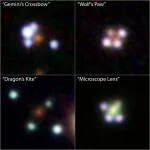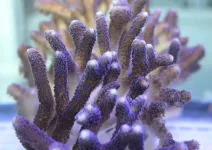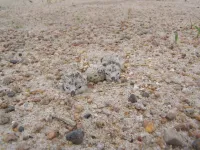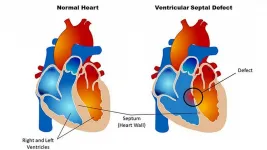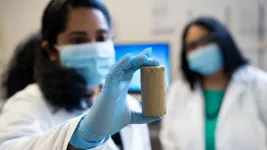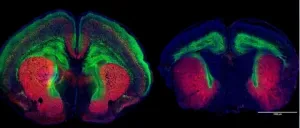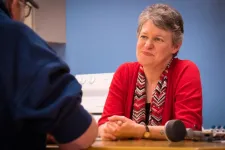(Press-News.org) With the help of machine-learning techniques, a team of astronomers has discovered a dozen quasars that have been warped by a naturally occurring cosmic "lens" and split into four similar images. Quasars are extremely luminous cores of distant galaxies that are powered by supermassive black holes.
Over the past four decades, astronomers had found about 50 of these "quadruply imaged quasars," or quads for short, which occur when the gravity of a massive galaxy that happens to sit in front of a quasar splits its single image into four. The latest study, which spanned only a year and a half, increases the number of known quads by about 25 percent and demonstrates the power of machine learning to assist astronomers in their search for these cosmic oddities.
"The quads are gold mines for all sorts of questions. They can help determine the expansion rate of the universe, and help address other mysteries, such as dark matter and quasar 'central engines,'" says Daniel Stern, lead author of the new study and a research scientist at the Jet Propulsion Laboratory, which is managed by Caltech for NASA. "They are not just needles in a haystack but Swiss Army knives because they have so many uses."
The findings, to be published in The Astrophysical Journal, were made by combining machine-learning tools with data from several ground- and space-based telescopes, including the European Space Agency's Gaia mission; NASA's Wide-field Infrared Survey Explorer (or WISE); the W. M. Keck Observatory on Maunakea, Hawaii; Caltech's Palomar Observatory; the European Southern Observatory's New Technology Telescope in Chile; and the Gemini South telescope in Chile.
Cosmological Dilemma
In recent years, a discrepancy has emerged over the precise value of the universe's expansion rate, also known as Hubble's constant. Two primary means can be used to determine this number: one relies on measurements of the distance and speed of objects in our local universe, and the other extrapolates the rate from models based on distant radiation left over from the birth of our universe, called the cosmic microwave background. The problem is that the numbers do not match.
"There are potentially systematic errors in the measurements, but that is looking less and less likely," says Stern. "More enticingly, the discrepancy in the values could mean that something about our model of the universe is wrong and there is new physics to discover."
The new quasar quads, which the team gave nicknames such as Wolf's Paw and Dragon Kite, will help in future calculations of Hubble's constant and may illuminate why the two primary measurements are not in alignment. The quasars lie in between the local and distant targets used for the previous calculations, so they give astronomers a way to probe the intermediate range of the universe. A quasar-based determination of Hubble's constant could indicate which of the two values is correct, or, perhaps more interestingly, could show that the constant lies somewhere between the locally determined and distant value, a possible sign of previously unknown physics.
Gravitational Illusions
The multiplication of quasar images and other objects in the cosmos occurs when the gravity of a foreground object, such as a galaxy, bends and magnifies the light of objects behind it. The phenomenon, called gravitational lensing, has been seen many times before. Sometimes quasars are lensed into two similar images; less commonly, they are lensed into four.
"Quads are better than the doubly imaged quasars for cosmology studies, such as measuring the distance to objects, because they can be exquisitely well modeled," says co-author George Djorgovski, professor of astronomy and data science at Caltech. "They are relatively clean laboratories for making these cosmological measurements."
In the new study, the researchers used data from WISE, which has relatively coarse resolution, to find likely quasars, and then used the sharp resolution of Gaia to identify which of the WISE quasars were associated with possible quadruply imaged quasars. The researchers then applied machine-learning tools to pick out which candidates were most likely multiply imaged sources and not just different stars sitting close to each other in the sky. Follow-up observations by Keck, Palomar, the New Technology Telescope, and Gemini-South confirmed which of the objects were indeed quadruply imaged quasars lying billions of light-years away.
Humans and Machines Working Together
The first quad found with the help of machine learning, nicknamed Centaurus' Victory, was confirmed during an all-nighter the team spent at Caltech, with collaborators from Belgium, France, and Germany, while using a dedicated computer in Brazil, recalls co-author Alberto Krone-Martins of UC Irvine. The team had been remotely observing their objects using the Keck Observatory.
"Machine learning was key to our study but it is not meant to replace human decisions," explains Krone-Martins. "We continuously train and update the models in an ongoing learning loop, such that humans and the human expertise are an essential part of the loop. When we talk about 'AI' in reference to machine-learning tools like these, it stands for Augmented Intelligence not Artificial Intelligence."
"Alberto not only initially came up with the clever machine-learning algorithms for this project, but it was his idea to use the Gaia data, something that had not been done before for this type of project," says Djorgovski.
"This story is not just about finding interesting gravitational lenses," he says, "but also about how a combination of big data and machine learning can lead to new discoveries."
INFORMATION:
The Astrophysical Journal study, titled, "Gaia GraL: Gaia DR2 Gravitational Lens Systems. VI. Spectroscopic Confirmation and Modeling of Quadruply-Imaged Lensed Quasars," was funded by NASA, the National Science Foundation, the Portuguese Fundação para a Ciência e a Tecnologia, the Brazilian São Paulo Research Foundation, and the European Research Council. The study team, called GraL or Gaia Gravitational Lenses due to the importance of Gaia's astrometry to these discoveries, is a collaboration of researchers from Australia, Belgium, Brazil, France, Germany, India, Portugal, Switzerland, and the U.S.
Past surveys have shown that more than 80% of dog owners report observing jealous behaviors from their dogs--vocalizations, agitated behavior, pulling on a leash--when they give attention to other dogs. New research published in the journal Psychological Science supports these observations and finds that dogs also exhibit jealous behaviors when they merely imagine that their owner is interacting with a potential rival, in this case, a highly realistic artificial dog.
"Research has supported what many dog owners firmly believe--dogs exhibit jealous behavior when their human companion interacts with a potential rival," said Amalia Bastos with ...
Charles Darwin, the British naturalist who championed the theory of evolution, noted that corals form far-reaching structures, largely made of limestone, that surround tropical islands. He didn't know how they performed this feat.
Now, Rutgers scientists have shown that coral structures consist of a biomineral containing a highly organized organic mix of proteins that resembles what is in our bones. Their study, published in the END ...
A new study shows that several disagreements between Ethiopia, Sudan and Egypt around Africa's largest hydropower plant, the new Grand Ethiopian Renaissance Dam (GERD), could be alleviated by massively expanding solar and wind power across the region. Adapting GERD operation to support grid integration of solar and wind power would provide tangible energy and water benefits to all involved countries, creating regional win-win situations. "Our results call for integrated hydro-solar-wind planning to be taken up in the GERD negotiations," says Sebastian Sterl, energy ...
Piping plovers, charismatic shorebirds that nest and feed on many Atlantic Coast beaches, rely on different kinds of coastal habitats in different regions along the Atlantic Coast, according to a new study by the U.S. Geological Survey and U.S. Fish and Wildlife Service.
The Atlantic Coast and Northern Great Plains populations of the piping plover were listed as federally threatened in 1985. The Atlantic coast population is managed in three regional recovery units, or regions: New England, which includes Massachusetts and Rhode Island; Mid-Atlantic, which includes New ...
WHAT:
The COVID-19 pandemic is affecting people with or at risk for HIV both indirectly, by interfering with HIV treatment and prevention services, and directly, by threatening individual health. An effective response to these dual pandemics requires unprecedented collaboration to accelerate basic and clinical research, as well as implementation science to expeditiously introduce evidence-based strategies into real-world settings. This message comes from a review article co-authored by Anthony S. Fauci, M.D., director of the National Institute of Allergy and Infectious Diseases (NIAID), part of the National Institutes of Health, and colleagues published in the Journal of Infectious Diseases.
By disrupting critical health care services, the COVID-19 pandemic threatens ...
April 8, 2021 - Routinely collected data on patients undergoing spinal fusion surgery do not provide a valid basis for assessing and comparing hospital performance on patient safety outcomes, reports a study in Spine. The journal is published in the Lippincott portfolio by Wolters Kluwer.
At a time when hospitals are increasingly subject to online rankings or "pay-for-performance" reimbursement programs, metrics based on hospital administrative data are "unreliable for profiling hospital performance," concludes the new research by Jacob K. Greenberg, MD, MSCI, of Washington University in St Louis and colleagues. ...
In a medical records study covering thousands of children, a U.S.-Canadian team led by researchers at Johns Hopkins Medicine concludes that while surgery to correct congenital heart disease (CHD) within 10 years after birth may restore young hearts to healthy function, it also may be associated with an increased risk of hypertension -- high blood pressure -- within a few months or years after surgery. ...
Waste materials from the pulp and paper industry have long been seen as possible fillers for building products like cement, but for years these materials have ended up in the landfill. Now, researchers at UBC Okanagan are developing guidelines to use this waste for road construction in an environmentally friendly manner.
The researchers were particularly interested in wood-based pulp mill fly ash (PFA), which is a non-hazardous commercial waste product. The North American pulp and paper industry generates more than one million tons of ash annually by burning wood in ...
JUPITER, FL -- Damage to the autism-associated gene Dyrk1a, sets off a cascade of problems in developing mouse brains, resulting in abnormal growth-factor signaling, undergrowth of neurons, smaller-than-average brain size, and, eventually, autism-like behaviors, a new study from Scripps Research, Florida, finds.
The study from neuroscientist Damon Page, PhD, describes a new mechanism underlying the brain undergrowth seen in individuals with Dyrk1a mutations. Page's team used those insights to target the affected pathway with an existing medicine, a growth hormone. It restored normal brain growth in the Dyrk1a mutant mice, Page says.
"As of now, there's simply no targeted treatments available for individuals with autism spectrum ...
When you think of ways to treat opioid use disorder, you might think methadone clinics and Narcotics Anonymous meetings. You probably don't imagine stretches and strengthening exercises.
But Anne Swisher--professor at the West Virginia University School of Medicine--is working to address opioid misuse in an unconventional way: through physical therapy. She and her colleagues have enhanced physical therapy instruction at WVU to emphasize the profession's role in preventing and treating opioid use disorder.
"Students have different interests and passions within the profession, and they find their niche," said Swisher, a researcher and director of scholarship in the Division of Physical Therapy. "No matter what their passion is, there ...
